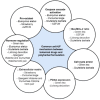Evidence-Based Management of Uterine Fibroids With Botanical Drugs-A Review
- PMID: 35800452
- PMCID: PMC9256340
- DOI: 10.3389/fphar.2022.878407
Evidence-Based Management of Uterine Fibroids With Botanical Drugs-A Review
Abstract
Uterine fibroids (UFs) are a common benign gynecological tumor that affect the majority of women over their lifetime. Several pharmacological agents are available to reduce the size of fibroids and ameliorate the symptoms of UF. However, these drugs are expensive and are usually associated with profound side effects. Thus, botanical drugs are gaining attention in this era due to their cost effectiveness with a comparable and more potent therapeutic efficacy while demonstrating lesser adverse effects. The objective of this review is to summarize the available information on the mechanism of various botanical drugs and polyherbal formulations with anti-uterine fibroid activity. A systematic search was performed on botanical drugs with anti-uterine fibroid activity using several search engines, which include PubMed, Google Scholar, and Science Direct. Based on the literatures identified, a total of five botanical drugs and three polyherbal formulations were included and discussed in this review, which yields useful information regarding the mechanism of different botanical drugs and polyherbal formulations in exerting anti-uterine fibroid activity for its potential use as an alternative treatment choice for uterine fibroids.
Keywords: botanical drug; leiomyoma; management; mechanism; polyherbal; uterine fibroids.
Copyright © 2022 Arip, Yap, Rajagopal, Selvaraja, Dharmendra and Chinnapan.
Conflict of interest statement
The authors declare that the research was conducted in the absence of any commercial or financial relationships that could be construed as a potential conflict of interest.
Figures



References
-
- Al-Hendy A., Venturella R., Arjona Ferreira J. C., Li Y., Wagman R. B., Lukes A. S. (2021). Liberty Randomized Withdrawal Study: 2-year Efficacy and Safety of Relugolix Combination Therapy in Women with Heavy Menstrual Bleeding Associated with Uterine Fibroids. Fertil. Steril. 116, e2. 10.1016/j.fertnstert.2021.07.014 - DOI - PubMed
Publication types
LinkOut - more resources
Full Text Sources

